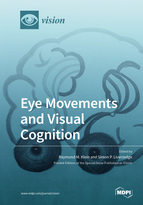Eye Movements and Visual Cognition
A special issue of Vision (ISSN 2411-5150).
Deadline for manuscript submissions: closed (28 February 2019) | Viewed by 102571
Special Issue Editors
Interests: human perception; attention; cognition & performance; cognitive neuroscience; applied cognitive psychology
Special Issues, Collections and Topics in MDPI journals
Special Issue Information
Dear Colleagues,
We invite submissions for a Special Issue on the topic of “eye movements and visual cognition”.
In keeping with the overall aim of the journal, to stimulate useful an interchange between individuals working primarily on basic theoretical issues and those working on more applied aspects of vision science, we invite papers on a range of topics related to the theme of “eye movements and visual cognition”. We are particularly interested in papers that review particular topics within this broad field. Such reviews might be narrative (critiquing and summarizing research on a particular topic), tutorial (with a focus on methods and findings), empirical (e.g., meta-analytic), or theoretically synthetic (or some combination of these types). We will also consider papers with new empirical content when this emerges to resolve an undecided issue from such a review. Papers that seek to bridge the gap between theoretical and applied aspects, and between behavior and its neural substrate, will be especially welcome. Some examples of possible topics for this Special Issue are provided below. This should be viewed as a suggestive list, rather than an exhaustive catalogue. Individuals unsure about whether a proposed submission would be appropriate are invited to contact one of the Special Issue Editors, Raymond Klein or Simon Liversedge.
- Eye movements in reading
- Foveal and parafoveal processing
- Oculomotor control and saccadic targeting
- Reading in special populations
- Eye movement control in reading across languages
- Changes in reading with age
- Neural correlates of reading
- Eye movements in scene perception
- Bottom-up versus top-down control
- Change blindness
- Dynamic scenes and multiple object tracking
- Eye movements in visual search
- Visually guided reaching
- Attention and eye movements
- Oculomotor capture
- Does attention precede saccades
- Inhibition of return
- Natural viewing
- Real scenes and non-laboratory studies
- Working memory
- Navigation, wayfinding, and foraging
- Problem solving
- Visual stability despite eye movements
- Disorders of the oculomotor system
- Development of oculomotor control
- Eye movements for perception and action
- Changes in pupil size
Prof. Dr. Raymond M. Klein
Prof. Dr. Simon P. Liversedge
Guest Editors
Manuscript Submission Information
Manuscripts should be submitted online at www.mdpi.com by registering and logging in to this website. Once you are registered, click here to go to the submission form. Manuscripts can be submitted until the deadline. All papers will be peer-reviewed. Accepted papers will be published continuously in the journal (as soon as accepted) and will be listed together on the special issue website. Research articles, review articles as well as short communications are invited.
Submitted manuscripts should not have been published previously, nor be under consideration for publication elsewhere (except conference proceedings papers). All manuscripts are thoroughly refereed through a single-blind peer-review process. A guide for authors and other relevant information for submission of manuscripts is available on the Instructions for Authors page. Vision is an international peer-reviewed open access quarterly journal published by MDPI.
Please visit the Instructions for Authors page before submitting a manuscript. The Article Processing Charge (APC) is waived for well-prepared manuscripts submitted to this issue. Submitted papers should be well formatted and use good English. Authors may use MDPI's English editing service prior to publication or during author revisions.







